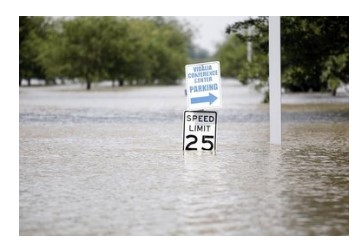Flood Index
Emergency Information
Floods are one of the most common hazards in the United States, however not all floods are alike. Some floods develop slowly, while others such as flash floods can develop in just a few minutes and without visible signs of rain. Additionally, floods can be local, impacting a neighborhood or community, or very large, affecting entire river basins and multiple states. Flooding is a significant potential threat throughout Trumbull County especially after the winter thaw.
Most injuries and deaths related to flooding events occur when people are swept away by flood currents, and most property damage results from inundation by sediment and debris-filled water.
Flash Flooding
Flash floods can occur within a few minutes or hours of excessive rainfall, or a dam or levee failure. Overland flooding, the most common type of flooding event typically occurs when waterways such as rivers or streams overflow their banks as a result of rainwater or a possible levee breach and cause flooding in surrounding areas. It can also occur when rainfall exceeds the capacity of underground pipes, or the capacity of streets and drains designed to carry flood water away from urban areas.

River Flooding
Trumbull County has special flood hazard areas that are subject to periodic inundation which may result in loss of life and property, health and safety hazards, disruption of commerce and governmental services, extraordinary public expenditures for flood protection and relief, and impairment of the tax base. Additionally, structures that are inadequately anchored, elevated, flood-proofed, or otherwise protected from flood damage also contribute to the flood loss.
An application for a floodplain development permit shall be required for all development activities located within or in contact with an identified special flood hazard area. Such application shall be made by the owner of the property or his/her authorized agent, prior to the actual commencement of such construction. Where it is unclear whether a development site is in a special flood hazard area, the Floodplain Administrator may require an application for a floodplain development permit to determine the development’s location. It shall be unlawful for any person to begin construction or other development activity, including but not limited to, filling; grading; construction; alteration, remodeling, or expanding any structure; or alteration of any watercourse wholly within, partially within or in contact with any identified special flood hazard area, until a floodplain development permit is obtained.
What to do before a flood?
- Plan for evacuation. Know where you are going and how to get there
- Prepare your home for a flood. Call your local building department or office of emergency management for information.
- Purchase flood insurance.
- Keep all insurance policies and a list of valuable items in a safe place.
- Take photos or a videotape of the valuables you keep in your home.
- Listen to your radio or television for reports of flood danger.
- Keep your car filled with gas.
What to do before a flood?
- Do NOT try to walk or drive through flooded areas. Water can be deeper than it appears and water levels rise quickly. Follow official emergency evacuation routes. If your car stalls in floodwater, get out quickly and move to higher ground.
- Stay away from moving water: moving water six inches deep can sweep you off your feet. Cars are easily swept away in just two feet of water.
- Stay away from disaster areas unless authorities ask for volunteers.
- Stay away from downed power lines.
- If your home is flooded, turn the utilities off until emergency officials tell you it is safe to turn them on. Do not pump the basement out until floodwater recedes. Avoid weakened floors, walls and rooftops.
- Wash your hands frequently with soap and clean water if you come in contact with floodwaters.
What to do after a flood?
- Wear gloves and boots when cleaning up.
- Open all doors and windows. Use fans if possible to air out the building.
- Wash all clothes and linens in hot water.
- Discard mattresses and stuffed furniture. They can't be adequately cleaned.
- Wash dirt and mud from walls, counters and hard surfaced floors with soap and water. Then disinfect by wiping surfaces with a solution of one cup bleach per gallon of water.
- Discard all food that has come into contact with floodwater. Canned food is alright, but thoroughly wash the can before opening.
- If your well is flooded, your tap water is probably unsafe. If you have public water, the health department will let you know - through radio and television - if your water is not safe to drink. Until your water is safe, use clean bottled water.
- Learn how to purify water. If you have a well, learn how to decontaminate it.
- Do not use your septic system when water is standing on the ground around it. The ground below will not absorb water from sinks or toilets. When the soil has dried, it is probably safe to again use your septic system. To be sure, contact your local health department.
- When floodwaters have receded watch out for weakened road surfaces